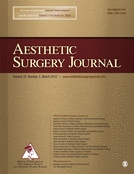-
PDF
- Split View
-
Views
-
Cite
Cite
Thomas C. Wiener, Minimizing Capsular Contracture in a “Clean-Contaminated Site”, Aesthetic Surgery Journal, Volume 32, Issue 3, March 2012, Pages 352–353, https://doi.org/10.1177/1090820X11433819
Close - Share Icon Share
I read with interest the excellent article by Bartsich et al1 in the September issue of Aesthetic Surgery Journal. The research methods were outstanding, and I congratulate the authors on an important contribution to outcomes in breast augmentation. The data presented confirm other published findings regarding cultures of ductal fluid at the time of breast surgery and also provide a good follow-up to my own article (published in 2008) regarding the relationship of capsular contracture (CC) to incision location in breast augmentation.2
As we have all seen when performing breast augmentation through a periareolar incision, there are times when milky fluid is noted in the operative field as the breast tissue is dissected. It is anatomically obvious that a periareolar incision (as compared to an inframammary incision) will transect many more ducts, and larger-diameter ducts closer to the external environment have a much greater likelihood of harboring bacterial colonies. Since I generally dislike doing capsulectomies, like most of us, I want to do my best to minimize CC in my practice. A reduction in CC also reduces patient dissatisfaction and the risks of a more involved surgical procedure. Since my 2008 article, I have performed only one or two breast augmentations with a periareolar incision per year. Although I certainly believe the periareolar incision is a standard of care, when a patient undergoes a consultation with me and initially desires a periareolar incision, I am careful to explain the significantly higher risk of CC and the possibility of revision surgery. Most patients will then choose an inframammary incision. If a patient is determined to have a periareolar incision, I will proceed, but I once again state (and make sure that the patient acknowledges) that the risk of contracture is higher, although I also emphasize that contracture can occur with any incision. I document this discussion in the record.
With regard to prevention, the extensive research by Dr. Adams has gone a long way.3 His triple antibiotic protocol shows a definite decrease in the risk of contracture. Bartsich et al1 implied that Betadine irrigation has not been shown to affect the rate of CC, but I must disagree. Another article I published in 2007 showed a significant decrease in the rate of CC with appropriate Betadine irrigation of the breast pocket.4 Dr. Adams and I have discussed our outcomes many times, and we concur with each other that antibiotic irrigation has reduced our rates of CC. In addition to his triple antibiotic protocol, Dr. Adams has occasionally added Betadine. Both methods are effective; I choose the Betadine method because of a decrease in cost and the increased potential for issues such as allergic reaction with other various antibiotics. I do use the triple antibiotic method, however, when a patient is allergic to Betadine.
In the Discussion section of the Bartsich et al1 article, the authors allowed for broader-spectrum antibiotic coverage with a periareolar incision. Although initially this would seem to be a reasonable recommendation, it is not one that I would make for a primary breast augmentation. With the increasing incidence of antibiotic resistance both in the hospital and the community at large, we—as board-certified plastic surgeons—must lead the pack in making wise choices. There have been a number of articles in the plastic surgery literature, from both plastic surgeons and infectious disease specialists, stating that the recommendation for primary augmentation is still cefazolin preoperatively and cephalexin postoperatively for no more than one to two days in the nonallergic patient. With well over 300,000 breast augmentations performed yearly in the United States, this is not a small exposure of the population to antibiotics. Even what seems to be a short course of broader-spectrum antibiotics can certainly contribute to increased resistance across the population. The exception to this would be a salvage operation, such as a patient with a previous, unilaterally-infected implant with a resistant organism, or capsulectomy on a patient with a documented history of infection in other parts of the body with resistant bacteria.
I believe the main method of CC prevention is educating the patient regarding the increased incidence of CC and potential infection with a periareolar incision, as well as for the patient who does not have a strong preference, making a recommendation for the inframammary incision. Bartsich et al1 did mention irrigation of the breast pocket with triple antibiotic solution, and as I stated above, I highly recommend either this protocol or Betadine.
Disclosures
The author declared no potential conflicts of interest with respect to the research, authorship, and publication of this article.
References



